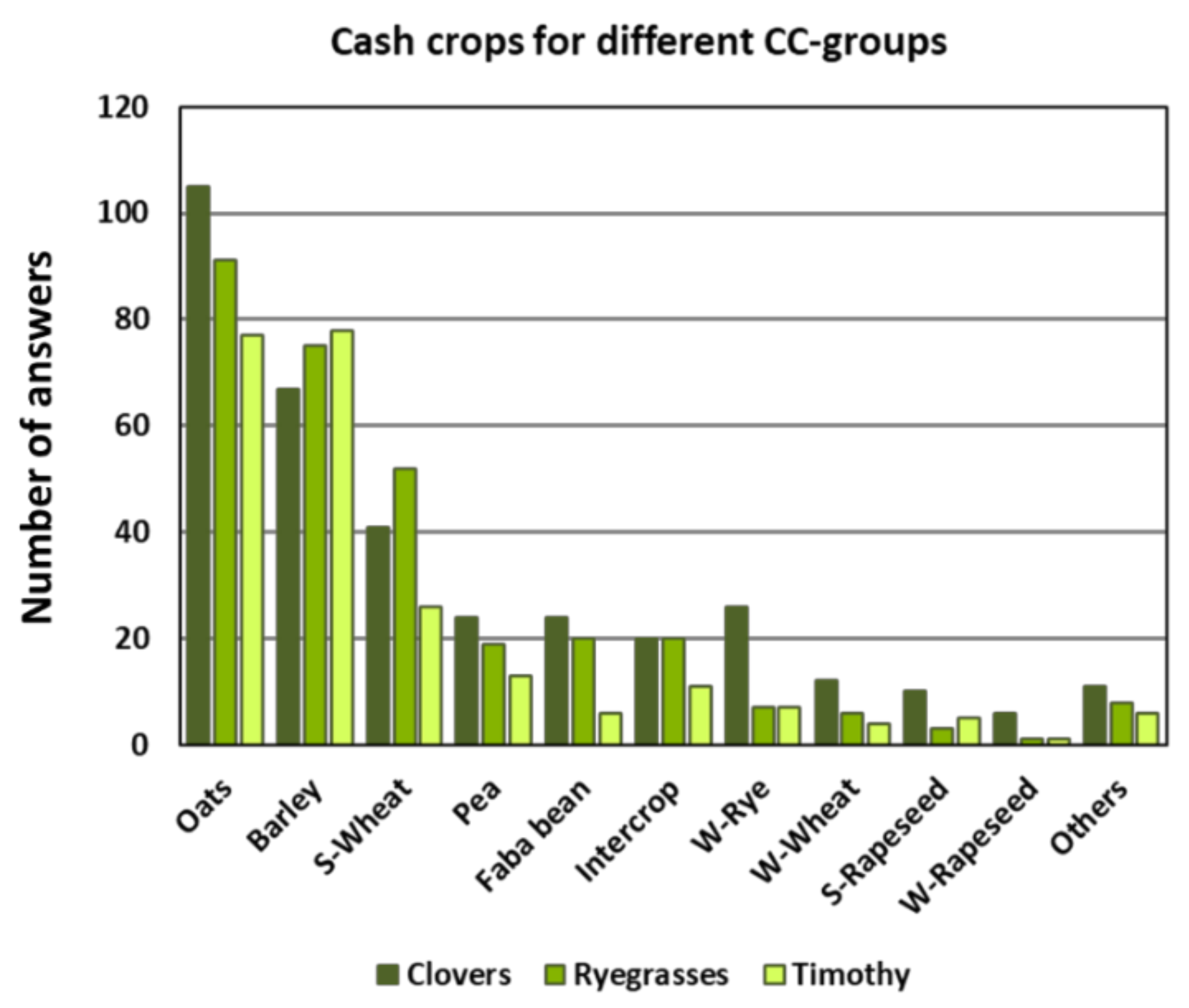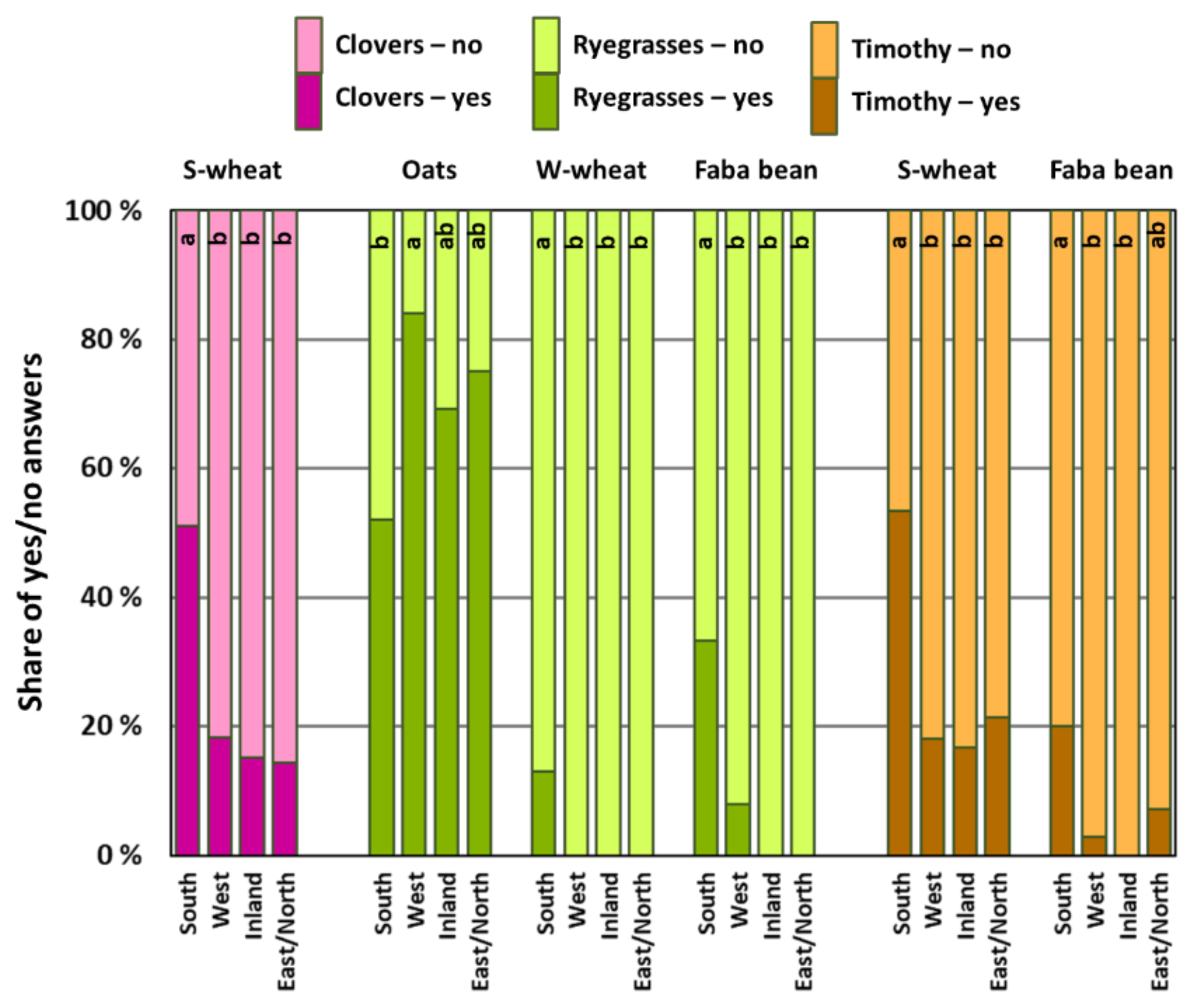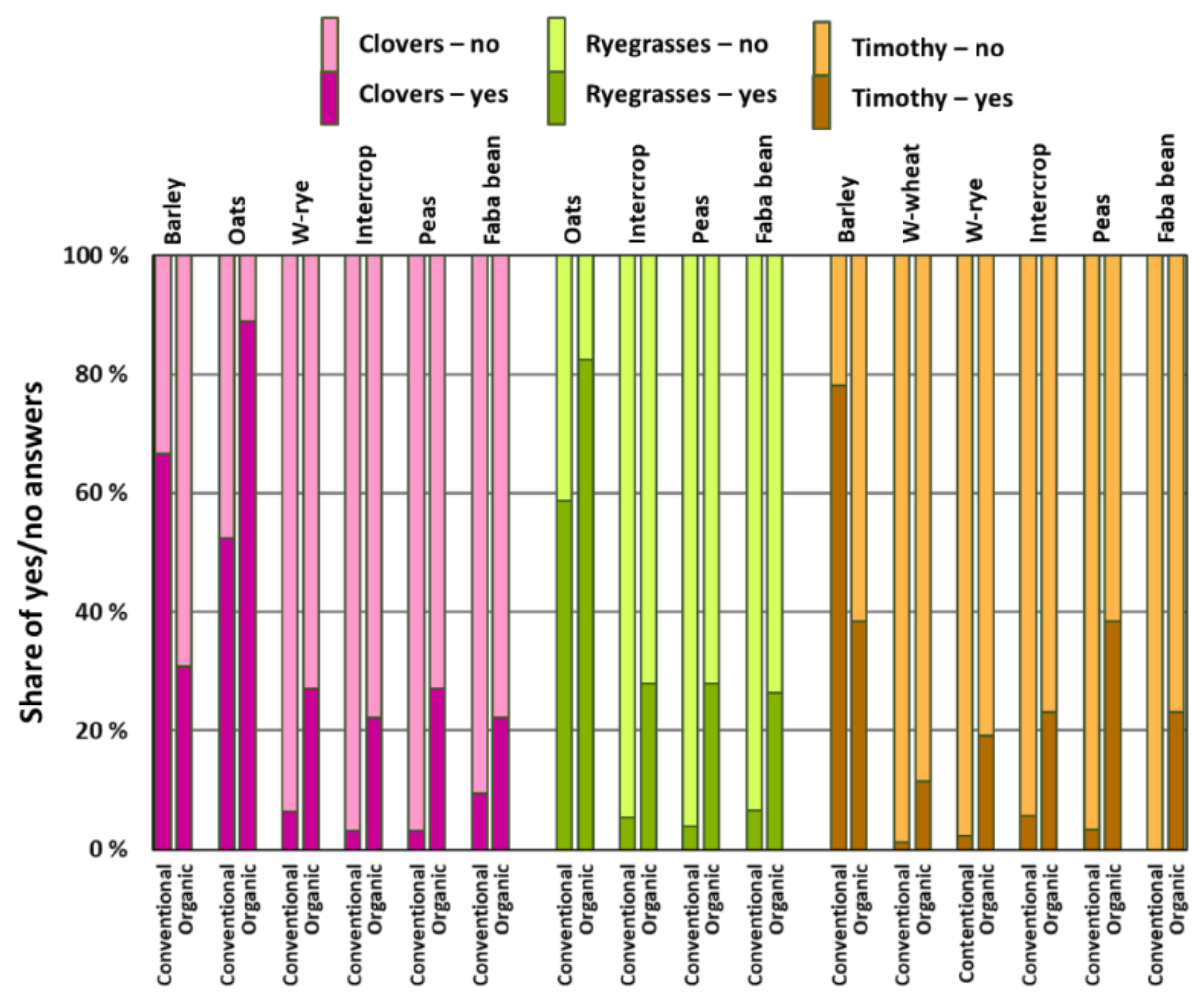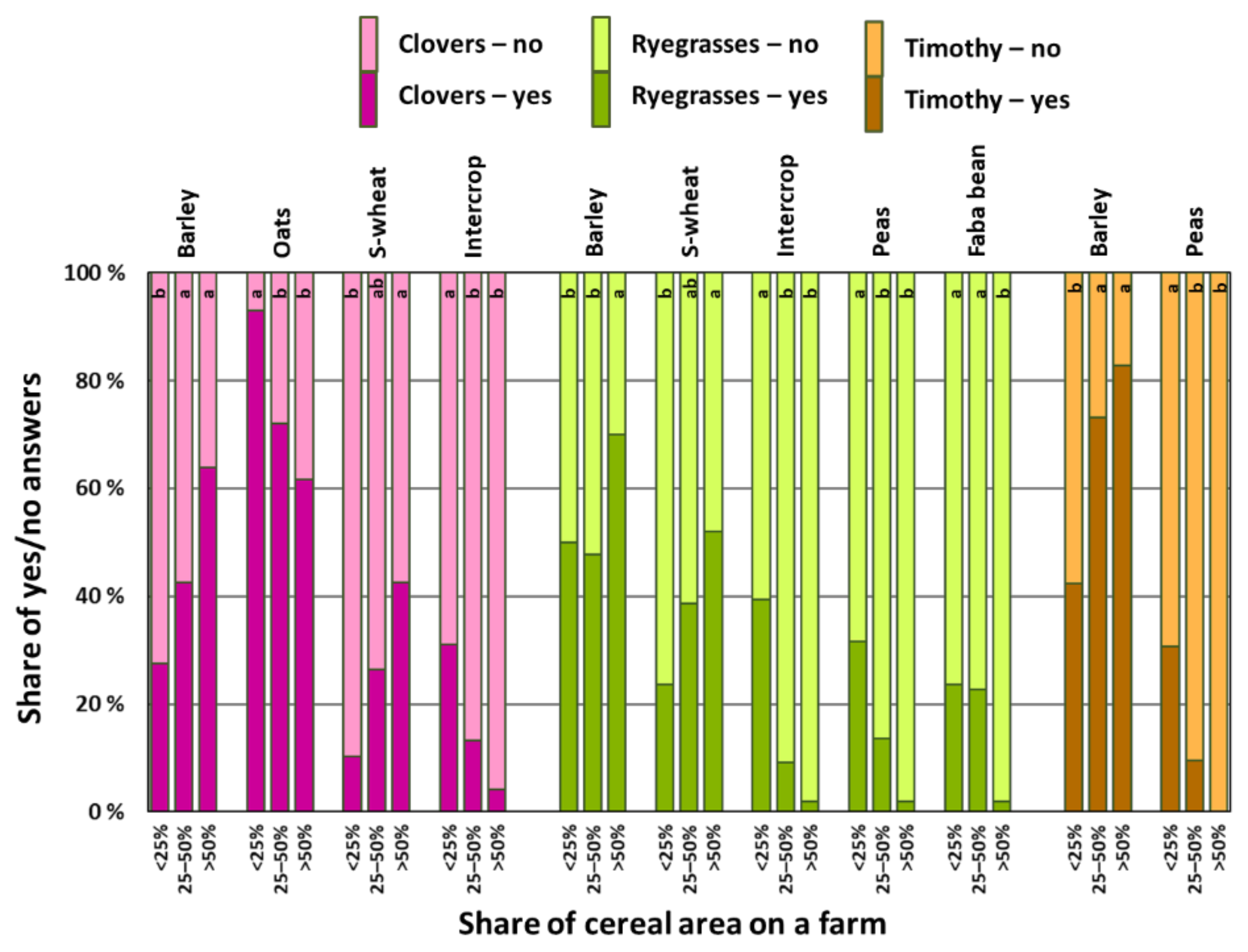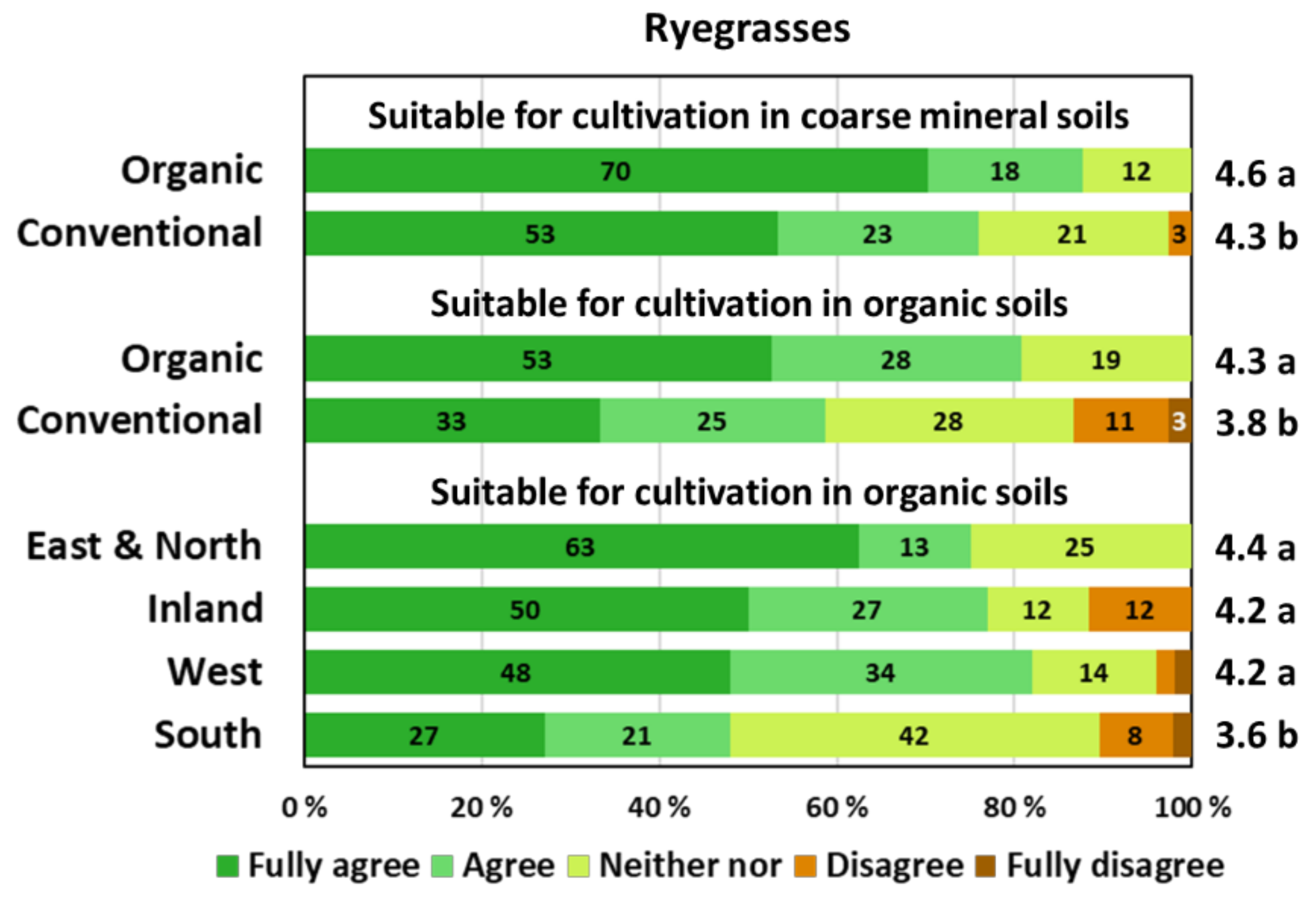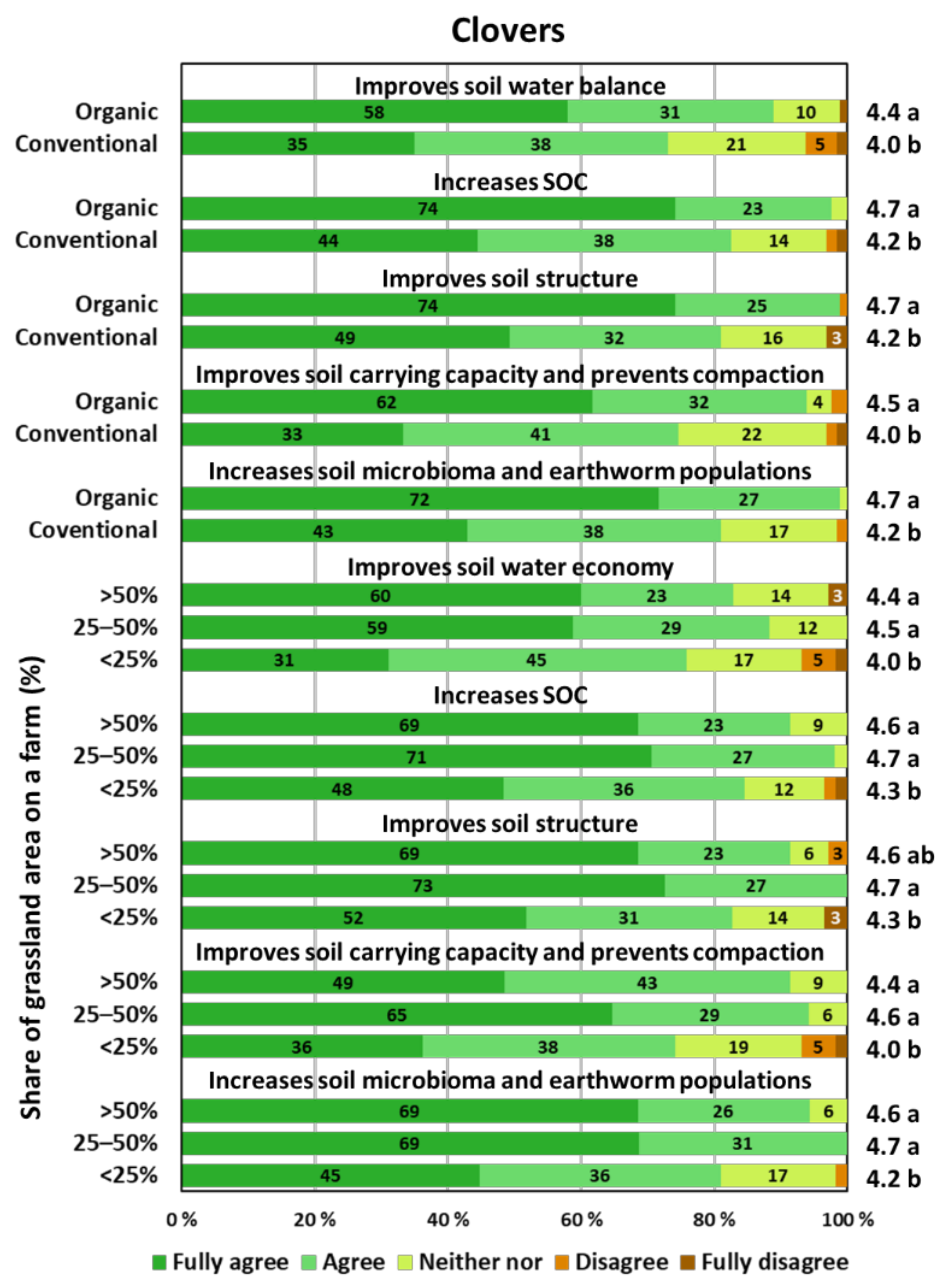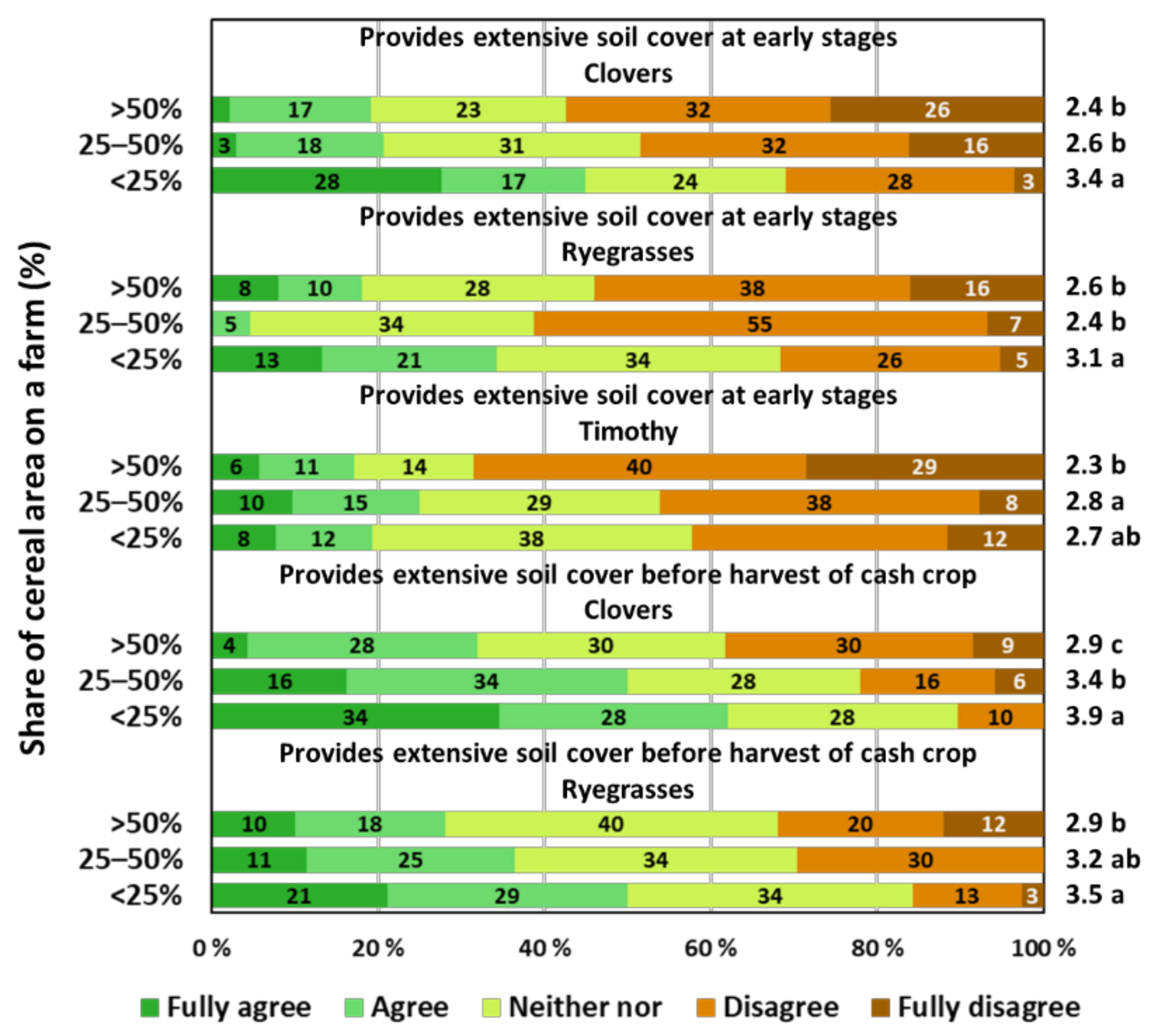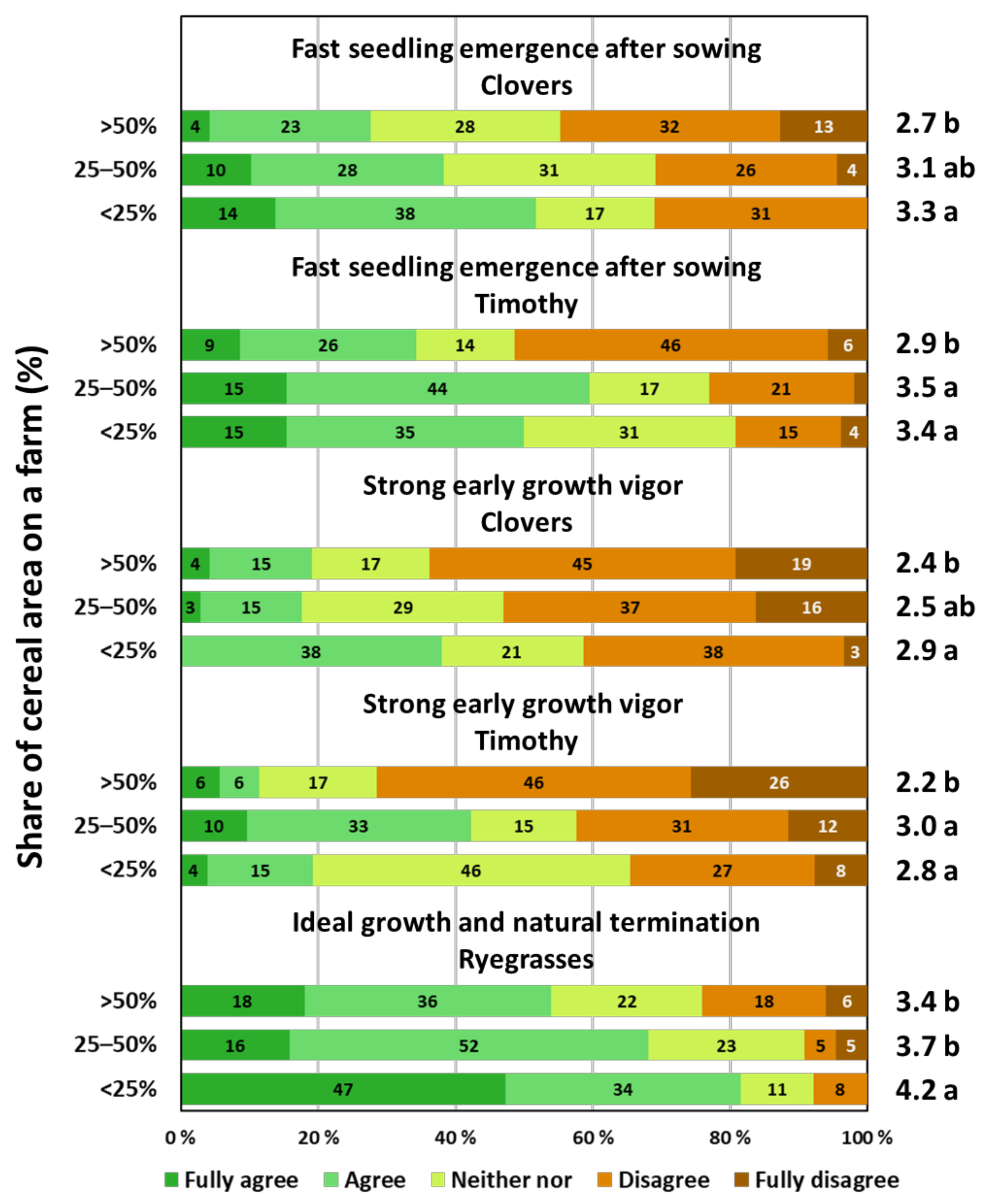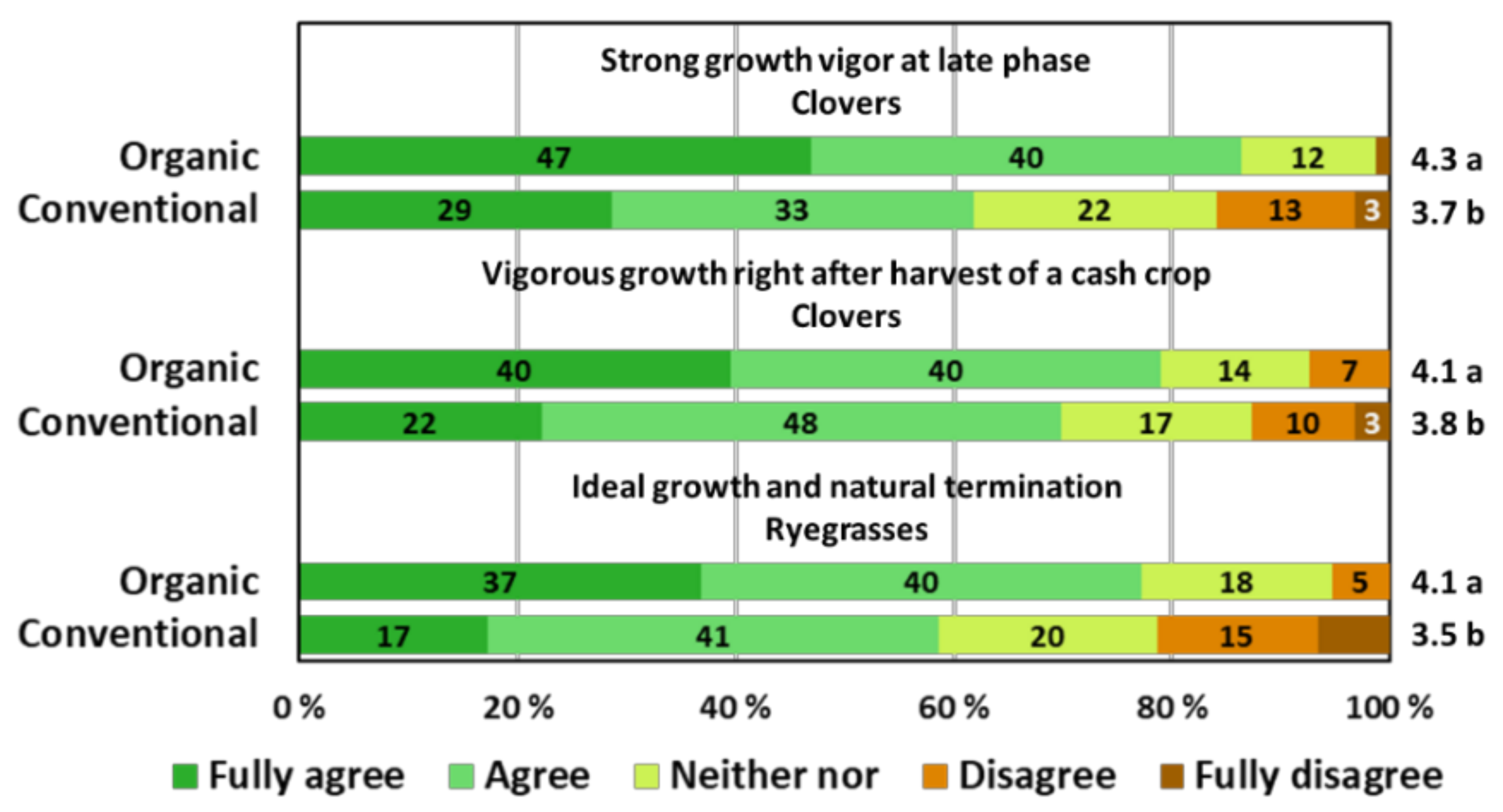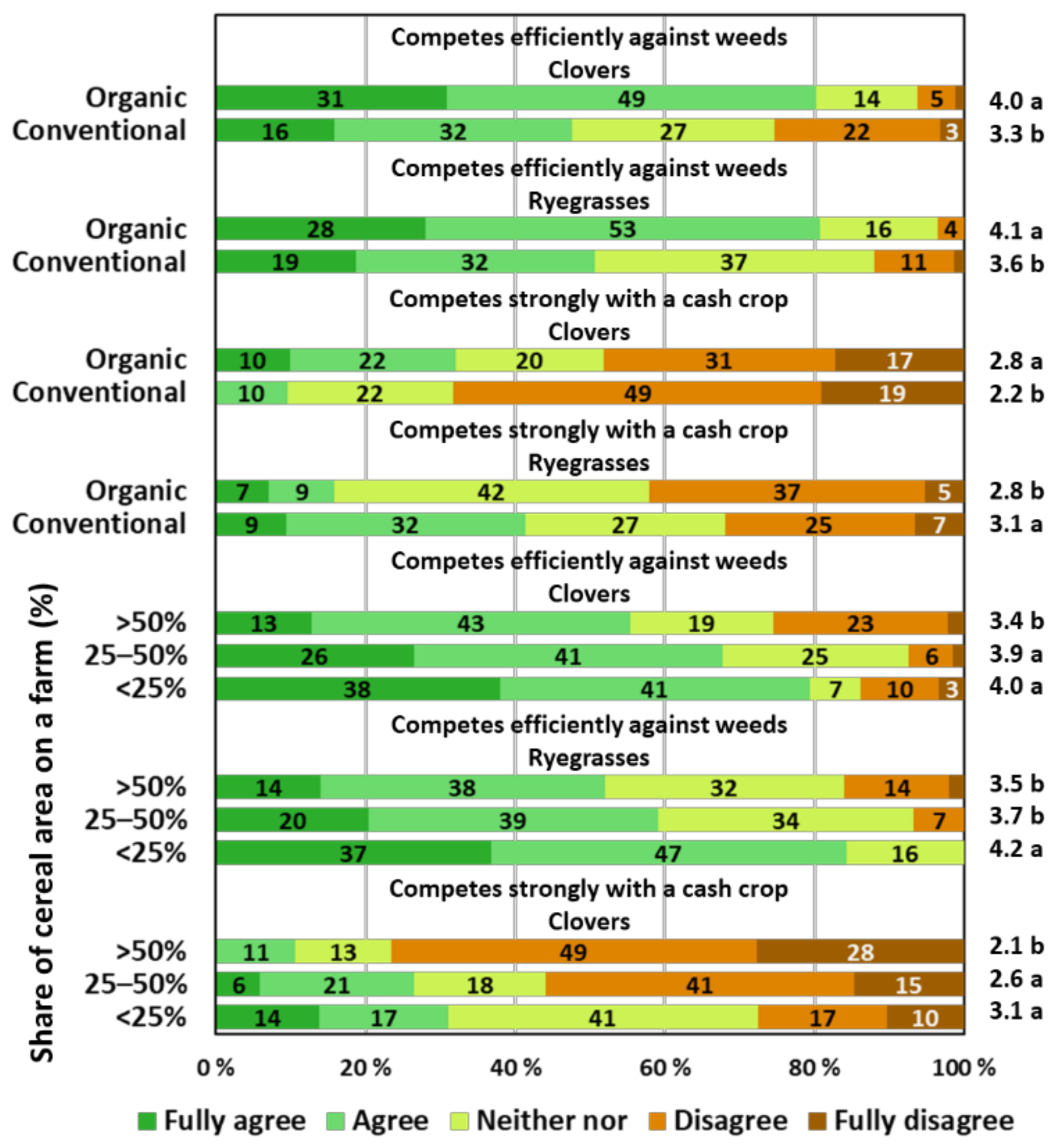1. Introduction
The cultivation of cover crops (CCs) aims to minimize the period of bare field area and simultaneously provide many valuable ecosystem services for the food production system and environment [
1,
2]. Keeping green plant cover on fields, preferably during all seasons, provides synergies to sustain agricultural production capacity, enhance biodiversity, and mitigate climate change. Hence, CCs are one of the identified and recommended options to make agriculture more regenerative and to achieve the goals set by both European Union Farm to Fork and Biodiversity Strategies [
3].
Recent research has highlighted at an accelerating pace many potential benefits provided by CCs, but it has also revealed how context-dependent achievements with CCs may be. Hence, more research and data are needed to better understand the multi-functional nature of the CCs in different regions, growing conditions, and management systems [
1]. The yield is an importance measure of success for many farmers. In general, cash crop yields have increased with cover cropping [
2]. However, the impacts of CCs on the yield may range depending on conditions, cash crop, and CC choices.
Finnish farmers have been increasingly interested in the cultivation of CCs [
4,
5]. This means that early adopters of CCs have implemented an extensive, national-scale living-lab on their farms. Understanding how farmers adopt, use, cope with risks, value, and finance the cultivation of CCs (including all the trials and errors during adoption) provide valuable insights into the state of knowhow on farms [
6]. Such an understanding can be used as further support for farmers aiming to continue with CCs as well as the next wave of farmers to start the cultivation of CCs and policymakers to identify focal points when incentivizing the transformation towards the use of CCs [
7]. Helping farmers to better understand the benefits of CCs and how these can be enhanced, and the potential risks and means to minimize them, might allow farmers to better weigh the benefits and costs of CC use [
6,
8]. Transformation may also call for technical support [
6].
With this study, we aimed to gather early-adopter farmers’ experiences and benefit from the hidden information available from the existing living lab of farms where farmers have adopted CCs into their production systems. Such understanding is highly relevant for knowledge sharing with other farmers, as interest towards cultivation of CCs has increased in northern European agricultural systems [
4]. Hence, we hypothesize that such a hidden understanding gives a valuable insight in farmers’ experiences with under-sown CCs and that farmers’ experiences vary depending on production conditions. Under-sown CC grows below the cash crop, and it is sown either simultaneously with the primary crop, before it, or after. Under-sown CCs that dominate in Finland were the focus of this study. A structured survey was used to collect novel data on farmers’ experiences with CCs considering their regional suitability, growth performance, competition, and impacts on soil conditions and cash crop yields. Furthermore, the aim was to understand: (1) how farmers’ experiences are in line with published results and (2) how experiences vary depending on prevailing growing conditions, farming system, and share of cereal and grassland area on a farm.
2. Materials and Methods
The farmer survey was carried out in Finland in spring 2021. In total, the details of 7025 farms (16% of Finnish farms in 2021) were received from the registry of the Finnish Food Authority (FFA). These included the farm identification number, farm type, location, parcel identification number with CCs, and the farmer’s email-address. The farmers whose data was sought from the FFA owned organic and conventional farms that applied for agricultural payments for CCs in 2020. Agricultural payments were registered on the parcel scale. With these definitions, the FFA provided requested data on 5593 conventional farms and 1432 organic farms that had implemented CC measures. As the farmers were contacted by email, only those whose email addresses were available in the registry of the FAA were used. The total number of invited farmers was 6493. The survey started on 16 March 2021 and ended on 11 April 2021. Survey respondents had to answer all the questions of the survey to be able to return their answers. In total, 1130 farmers answered the survey (17.4% response rate).
This paper concentrates on the farmers’ experience-based answers on growth performance of under-sown CCs only. The primary question studied in this paper was “What do you think about the following statements based on your experience on an under-sown CCs?” The survey also included other questions dealing with CCs, but the respondent was informed that this part of the survey focused only on CCs sown under cash crops. In total, 28 CC-species were listed and from these each respondent selected those they were familiar with or wrote an additional species in an open space. Thereafter, the respondent was asked to select, one by one, as many CCs as he/she wanted (one was, however, obligatory) to be able to progress with the questionnaire. In the case that the farmer used the selected CC for under-sowing on the farm, the respondent was asked to tick all the cash crops for which he/she had used it. Thereafter, the respondent had to answer 27 specific statements on growth performance of the selected under-sown CC (
Table 1). For each of the statements the respondent had five answer choices: 1 = fully disagree, 2 = disagree, 3 = neither agree nor disagree, 4 = agree, and 5 = fully agree. The respondents had to give answers to all 27 statements to be able to continue with the other parts of the questionnaire and submit it.
The respondents selected, in total, 410 times CCs that they had used for under-sowing. This means that most often farmers had not used selected CC for under-sowing and hence they were not directed to answer specific questions related to under-sown CCs only. The gathered data included clovers [144 cases (n)] [Trifolium repens L. (n = 63), T. pratense L. (n = 58), and the rest without specification of the species (n = 23)], ryegrasses (n = 132) [Lolium multiflorum L. (n = 112), L. perenne L. (n = 14), L. multiflorum west. L. (n = 2), and the rest without specification of the species (n = 2)] and timothy (Phleum pratense L.; n = 113). Only in 21 cases had the farmers selected some other CC: fescues (Festuca pratensis, F. rubra subsp. rubra and F. arundinaceae L.), Medicaco sativa L., Melilotus alba L., Phacelia tanacetifolia L., Cichorium intybus var. sativum L. or Lotus corniculatus L.
The background information was available for 2020 in the registry of the FFA by using the farm identity number. After merging the datasets, the respondents were grouped for statistical analyses according to: (1) the geographical region their farms were located in (merging 16 Centers for Economic Development, Transport and the Environment, ELY Centers to form 4 main regions: South-, West-, East/North-Finland, and the inland region), (2) farming system (organic and conventional) they operated, and (3) the share of land farmer had devoted to cereals and (4) grassland on a farm.
The Cochran–Mantel–Haenszel test (CMH) was used to test the relationship between the row and column variables. The row variables were different characteristics of respondents (e.g., region and farming system) and column variables were three different CC-groups (clovers, ryegrasses, and timothy) or several statements on agronomic performance asked with 5-point Likert scale. The CMH is useful to test association between two categorical variables (i.e., K × L contingency table). An alternative for this is ordered logistic regression, which is not suitable for this study because some levels of column variables have few observations. There are three different versions of the test. Version 1, “Nonzero Correlation”, is useful for linear associations between two sets of ordinal scale variables. This assumes that the order in rows and columns is meaningful. A 5-point Likert scale is ordinal; likewise, some row variables are ordinal (four levels from small to big farms). Version 2, “Row Mean Scores Differ”, is useful for one set of ordinal variable by one set of nominal variable. A 5-point Likert scale is ordinal and some row variables are nominal (e.g., region: South-, West-, East/North-Finland, and the inland region). Version 3, “General Association Statistics”, is useful for two sets of nominal variables having no assumptions for order. This is useful to test association between three CC-groups and nominal variables such as region. Version 3 is not statistically powerful for ordinal variables (such as variables measured at 5-point Likert scale). If the statistically significant relationship was found, pairwise post hoc test was done by one-way analysis of variance. All statistical tests were performed using SAS/FREQ and SAS/GLM procedures.
3. Results
Different clovers and ryegrasses as well as timothy were most often (in 95% of all responses) selected by farmers as the under-sown CCs. Clovers and ryegrasses were commonly sown under oats (
Avena sativa L.), barley (
Hordeum vulgare L.), and spring wheat (
Triticum aestivum L.). Timothy was sown quite equally under barley and oats (
Figure 1). Farmers had little experience with other cash crops for under-sown timothy. Clovers and ryegrasses were used as under-sown CCs for pea (
Pisum sativum L.), faba bean (
Vicia faba L.), and cereal intercrops. Clovers were sown under winter rye (
Secale cereale L.) more often than ryegrasses and timothy. Respondents had only scattered experience in sowing any of the CC-groups under winter wheat and spring or winter rapeseed (
Brassica rapa L.,
B. napus L.).
The region had an impact on how farmers combined under-sown CCs and cash crops. In South-Finland, half of the farmers had experience of sowing clovers under spring wheat, while elsewhere the share of farmers was <20% (
Figure 2). More than half of the respondents in South-Finland were familiar with sowing ryegrasses under oats, while in West-Finland the share was 84% and for the rest of the country it ranged from 69% to 74%. In South-Finland, 53% of the respondents had experience of sowing timothy under spring wheat, while elsewhere the share was around 20%. Ryegrasses were sown under winter wheat only in South-Finland, where farmers were also more experienced using ryegrasses and timothy as under-sown CCs for faba beans.
Organic farmers shared their experiences more actively than conventional farmers. Organic farmers were more experienced than conventional ones with clovers sown under oats, winter rye, cereal intercrops, peas, and faba beans (
Figure 3). They were most familiar with oats as a cash crop for under-sown clovers, while conventional farmers were most familiar with barley. Conventional farmers sowed ryegrasses mainly under oats, and very seldom under any other cash crop. Organic farmers sowed ryegrasses under oats, cereal intercrops, peas, and faba beans more often than conventional farmers, and they sowed timothy under any other cash crop than barley. Conventional farmers favored barley as a cash crop for under-sown timothy.
Farmers with a higher share of the cereal area on a farm had barley and spring wheat more frequently as the cash crops for under-sown clovers and ryegrasses than those with low shares (
Figure 4). If the cereal area on a farm was ≥25%, farmers favored barley as a cash crop for under-sown timothy. Oats were used very frequently as a cash crop for under-sown clover, and more often the lower the share of cereal area on a farm. The share of the cereal area had no impacts on how farmers used oats as cash crop for under-sown ryegrasses and timothy. Cereal intercrops were favored as cash crops for under-sown clovers and ryegrasses more often in the case of low than high cereal areas on a farm, as were peas for grown under ryegrasses and timothy. Farmers with >50% of land devoted to cereals had hardly any experience with clovers and ryegrasses under cereal intercrops, ryegrasses and timothy under peas, and ryegrasses under faba beans.
Farmers with a higher share of grassland on a farm had most experience with sowing clovers under oats, but also with cereal intercrops as a cash crop for under-sown clovers and ryegrasses (
Figure S1). Even though the experience with timothy as a CC was modest, it tended to be higher among farmers with more grassland on the farm. In such cases, it was sown under winter rye, cereal intercrops, and peas. Farmers with lower shares of grassland used ryegrasses under barley and spring wheat, but very seldom under cereal intercrops.
3.1. Soil Types, Soil Health, and Provided Soil Cover
All the three main soil types, clay, coarse mineral, and organic soils were agreed to be suitable for under-sowing of clovers, ryegrasses, and timothy: CC-groups did not, however, differ in their suitability for clay soils (
Table 1,
Figure S2). Timothy was considered more suitable than clovers for both organic and coarse mineral soils, and more suitable than ryegrasses for organic soils.
The farmers’ experiences were dependent on farm characteristics especially in the case of ryegrasses and timothy. Organic farmers had slightly more positive experiences than conventional producers with ryegrasses as under-sown CCs on both coarse mineral and organic soils (
Figure 5). Only South-Finland differed from other regions in the answers that the farmers provided on the suitability of ryegrasses on organic soils, which was mainly attributable to a high share of neither agree nor disagree answers (i.e., the low share of organic soils in the region).
Farmers had very positive experiences regarding the impacts of all three CC-groups on soil health. They considered that especially under-sown clovers improved soil structure and soil water balance, and that clovers also increased SOC, microbiome, and earthworm populations more than ryegrasses and timothy (
Table 1,
Figure S2). On the other hand, farmers agreed that all CCs equally improved the soil carrying capacity and prevented soil compaction. The farm characteristics only had an impact on the farmers’ experiences with clovers. Even though farmers were very positive about the capacity of under-sown clovers to improve soil health, organic farmers were systematically more satisfied than conventional ones (
Figure 6). None of the organic producers disagreed that clovers contribute to increase in SOC, soil microbiome, and earthworm populations. When compared to organic producers, conventional farmers were more often uncertain about the impacts on soils (i.e., they neither agreed nor disagreed) rather than disagreed. Farmers with a higher share of their land area under grassland on the farm (≥25%) were quite systematically more positive about the experienced impacts of clovers as CCs on soil.
Farmers did not consider CC-groups to differ in their capacity to provide soil cover either at early growth stages or before harvest of a cash-crop (
Table 1). In general, they were quite skeptical about this capacity especially in the early stages. Farmers with a low share of cereal area on a farm (<25%), in particular, agreed more frequently that all CC-groups were capable of producing extensive soil cover at early growth stages (
Figure 7). The same was true for clovers and ryegrasses before the harvest of a cash crop. Organic farmers were more positive than conventional ones about the cover provided by clovers before a harvest (data not shown). After a harvest, ryegrasses were found to cover the soil more extensively than clovers or timothy (
Table 1).
3.2. Growth Performance
Compared to other under-sown CC-groups, ryegrasses were agreed more frequently to have fast seedling emergence as well as strong growth vigor in the late growth phase and right after the harvest of a cash crop (
Table 1,
Figure S3). According to the farmers’ experiences, none of the three CC-groups were superior in their early growth vigor, yet farmers with high cereal area on a farm (>50%) disagreed most often that clovers and timothy had had fast seedling emergence and strong early growth vigor (
Figure 8). Furthermore, ryegrasses (especially considering Italian ryegrass as the dominant species) were considered most ideal regarding growth and natural termination—especially by organic farmers (
Figure 9) and those with <25% cereal area on a farm (
Figure 8).
According to the farmers’ experiences, clover stands stayed lower than grass stands when used for under-sowing (
Table 1,
Figure S3). Ryegrasses were found to produce the most abundant biomass. An abundant biomass of under-sown ryegrasses was considered to cause problems for crop management more often than in the case of other CC-groups—yet there was often disagreement on this (
Figure S3). Timothy was found to produce the lowest amount of biomass, and farmers considered it suitable for use as mowed and crushed mulch. The suitability of CC biomass for use as living mulch or only when tilled into the soil did not differ depending on the CC-group.
3.3. Competition and Impacts on Yield
Farmers considered under-sown clovers and ryegrasses to compete more efficiently against weeds than timothy, but none of the CC-groups were considered to compete strongly with the cash crop (
Table 1,
Figure S3). Organic farmers agreed more frequently than conventional producers that under-sown clovers and ryegrasses competed efficiently against weeds (
Figure 10). Organic farmers agreed more frequently that clovers competed strongly with cash crops, while conventional farmers felt that ryegrasses did. The competition capacity of clovers and ryegrasses against weeds was considered higher by farmers with a lower share of area on their farm for cereals, as was competition with cash crops in the case of clovers.
Farmers disagreed that the studied CCs increased the risk of pathogen and pest infestations (
Table 1). It was agreed that under-sown clovers improved the cash crop yield in contrast to ryegrasses and timothy (
Table 1,
Figure S3). However, all the CC-groups were found to improve the yield of the following crop in rotation, and mostly by clovers.
4. Discussion
Finnish farmers were most experienced in using clovers, ryegrasses, and timothy for under-sowing (
Figure 1), yet they had tested >20 CC-species in total on their farms either as monocrops or in CC-polycultures [
9]. In other Nordic countries, subsidies have been directed more to inhibit nitrogen (N) leaching, with restricted amounts of clover seeds in CCs [
4], which has led to fewer CC species as compared to Finland. Given the northern climate, the number of CCs considered potentially interesting by Finnish farmers seems high and thereby the farmers’ focus on three main CC-groups is rational as clovers, ryegrasses and timothy are in general well adapted to Finnish growing conditions. However, the region had some impact on the CC-groups: clovers (
p-value = 0.05; 16.1%, 10.6%, 7.4%, and 12.2% for South-, West-, East/North-Finland, and the inland regions, respectively) and ryegrasses (
p-value = 0.03; 15.8%, 9.6%, 8.4%, and 9.6%) were slightly more commonly used CCs in South-Finland than elsewhere, while timothy was used more commonly in West- and North-Finland (
p-value < 0.001; 4.9%, 13.9%, 14.7%, and 4.4%).
Spring cereals are the most largely grown crops in Finland, and hence they were also the most common cash crops that were under-sown with CCs. Nonetheless, the relative share of under-sowing was lower for cereals (11%) than for faba beans (15%), legume-cereal intercrops (17%), and buckwheat (
Fagopyrum esculentum L., 22%) [
4,
5]. In this study, emerging experience was found with grain legumes, cereal intercrops, and winter rye, and more scarcely with winter wheat and rapeseed as cash crops for under-sown CCs. The numbers of answers for each combination of cash crop and CC-group varied. The descending order of cash crops (with ≥20 answers) for clovers was oats → barley → spring wheat → winter rye → peas and faba beans → cereal intercrops. For ryegrasses it was oats → barley → spring wheat → faba beans and intercrops, whereas for timothy barley and oats → spring wheat. How farmers allocated CC-groups to cash crops differed depending on the region, farming system, and area under cereals and grassland on a farm.
The main driver for regional differences in the farmers’ CC and cash crop combinations was the suitability of a cash crop to the prevailing conditions [
10]. Late maturing crops such as spring wheat and faba beans were more commonly used as cash crops in South-Finland than elsewhere. Climate conditions are a natural reason for main crop choice; similarly, CCs are practiced also in maize in Southern Scandinavia [
4], but not yet in Finland. Winter wheat is less winter-hardy than rye [
11] and farmers had experience with it as a cash crop with under-sown ryegrasses only in South-Finland. Oats are common across Finland, but oats have more alternative cash crops that may substitute oats in the south and hence it was least common for under-sowing of ryegrasses in South-Finland (
Figure 2). When considering the impacts of farming system on cash crop choices for different CC-groups, conventional farmers were found to favor barley and oats. Organic farmers were in turn more experienced with a wider range of cash crops including winter rye, grain legumes, and cereal intercrops, but these cash crops were not combined in the same way for all the CC-groups (
Figure 3). Readiness of organic farmers for diversify main crops is comparable to findings from other Nordic crop rotation studies involving CCs [
12,
13,
14]. These findings are not only attributable to more monotonous land use in conventional than organic farms [
15] but emphasize that conventional farmers are likely to aim for benefits provided by CCs especially in the case of monotonous cereal sequencing [
16]. This was further supported by the finding that farmers with a higher share of the area on a farm dedicated to cereals used barley as the primary cash crops for under-sowing of all CC-groups as well as spring wheat for clovers and ryegrasses (
Figure 4). Farmers with low shares of cereals on their farms more frequently favored oats as a cash crop for under-sown clovers, intercrops for clovers and ryegrasses, peas for ryegrasses, and timothy and faba beans for ryegrasses. These findings on the cereal shares on farms were in general contrary to those of grassland shares (
Figure S1).
In addition to the available crop choices, regions differ regarding the dominant soil type. According to the farmers the soil type was not an obstacle, but it rather steered cultivation of the most common CC-groups in Finland (
Table 1). All the three main soil types, clay, coarse mineral, and organic soils, were agreed to be suitable for the studied CC-groups. Timothy was considered more suitable than clovers for organic and coarse mineral soils, and more suitable than ryegrasses for organic soils. However, according to the farmers’ answers, the CC-groups did not differ in their suitability for clay soils. Organic farmers, who have more competence in cultivating CCs in Finland, had slightly more positive experiences compared to conventional producers regarfing the suitability of ryegrasses on organic and coarse mineral soils (
Figure 5). Suitability of grasses for cultivation in light soils is comparable to the findings from Denmark, where CCs are mainly used to inhibit pollution load to waters, and, therefore, use of N-fixing legumes is not allowed [
4]. Organic soils are more common at high latitudes in Finland, where the largest share of cropland is organic soils [
17]. Some 22% of the organic field area is in these northern regions [
17]. Hence, it is understandable that farmers in South-Finland were uncertain about the suitability of organic soils for CCs.
4.1. CCs Promote Soil Health Though Provide Extensive Soil Cover Only after Harvest
In accordance with many published meta-analyses [
1,
18,
19,
20,
21], Finnish farmers had positive experiences of the impacts of all the three CC-groups on soil heath and conditions—almost without any opposition (
Figure S2). Because of a comprehensive five-point soil quality test that has been favored by farmers as an optional measure of the Agri-Environment Scheme, farmers have gained plenty of understanding of all their parcels (exceeding 0.5 ha in size) considering: basic construction needs, impacts of agronomic measures, soil structure, compaction and water conditions, soil heath and biological activity, and quality and health of the plant stand. Hence, farmers’ answers are likely to largely reflect experiences.
Under-sown clovers were agreed to increase the soil microbiome and earthworm population, increase SOC, and improve the soil structure and soil water balance slightly more compared to ryegrasses and timothy (
Table 1). Organic farmers were systematically more pleased with their experiences with clovers as CCs, and none of them disagreed that clovers contributed to an increase in SOC, soil microbiome, and earthworm populations (
Figure 6). Their experiences are consistent with long-term experiments in Estonia [
14,
22] and Denmark [
13]. Foereid and Høgh-Jensen [
23] simulated highest increase in SOC when clover and grass were mixed as CC.
Farmers with a higher area of grassland on their farms (≥25%) tended to be more positive about the influence of clovers as a CC on soil. As clovers are often used in grassland mixtures, this may have further reinforced experience-based views on the beneficial impacts of clovers on soil conditions. Farmers agreed that all the CC-groups equally improved the soil-carrying capacity and prevented soil compaction. Heavy field machinery [
24,
25] and more abundant rains close to harvest [
26] expose the soil to compaction. According to the farmers’ experiences, this could be prevented quite equally with all the main CC-groups, even though the CC-groups were considered to differ in growth performance. Hence, the farmers considered that the CC-groups did not differ in their capacity to provide extensive soil cover until after harvest of a cash crop and then with the descending order of ryegrasses → clovers → timothy (
Table 1). Farmers with higher share of cereal area on their farms were less positive that clovers, ryegrasses, and timothy would provide extensive soil cover in the early stages and that clovers and ryegrasses would provide it by harvest (
Figure 7). Farmers with cereal-based systems on their farms may often have only short-term experiences with CCs and their management contrary to farms with low cereal areas (including organic farms): 40% of organic and 11% of conventional farms had cereals <25% of their field area (data not shown).
4.2. Differences in Growth Performance of CC-Groups
The high number of potential CCs also in high-latitude conditions [
9,
27,
28] means virtually endless options for seasonal growth performance to match the growth of the cash crops. This study is based on farmers’ experiences so far, and the mostly used cash crops for under-sown CCs were spring cereals. Spring barley, oats, and wheat differ in their growth performance, degree days needed from sowing to mature [
29], and tillering capacity [
30]. However, the growth differences between spring cereals have levelled off in Finland, where long days substantially enhance development, cause early maturation, and strengthen main stem dominance over tillers [
30]. Because the differences in growth between spring cereals are minor compared to those between CC-groups, this study focused on the growth performance of CC-groups per se without considering the impacts of cash crops on farmers’ experiences.
Karlsson-Stresse et al. [
27] found numerous differences when they screened a large number of CC-species for under-sowing by using criteria such as slow early growth, withstanding competition, and vigorous growth in autumn. According to the farmers’ experiences, none of the three CC-groups that dominate in Finland was superior in its early growth vigor. Nonetheless, ryegrasses were found to have the fastest seedling emergence and strongest late-season growth vigor (
Table 1), which agrees with [
28] that Italian ryegrass grows especially vigorously in the autumn. Farmers who had a large cereal area on their farms agreed least often that clovers and timothy had fast seedling emergence and strong early growth vigor, but no differences were found for ryegrasses (
Figure 9). Organic farmers more often considered than conventional farmers that clovers had strong growth vigor both before and after harvest of a cash crop (
Figure 8). This may be attributable to organic farmers’ longer experience with clovers and greater understanding of how their growth varies depending on the growing season. Furthermore, the use of N fertilization on conventional farms inhibits the growth of clovers but enhances that of the cereal cash crops, while, again, under-sown grasses benefit from fertilizer almost similarly to cereals [
31].
Farmers considered ryegrasses and clovers to be slightly more ideal than timothy regarding growth and natural termination of CC-stands (
Table 1). Organic farmers (
Figure 9) and those with ≤25% cereal area on a farm (
Figure 8) agreed most frequently with this statement, but only in the case of ryegrasses. Timothy has slow early growth, but as a perennial species it overwinters better than Italian ryegrass [
28]. Perennial clovers need tillage to be terminated in organic farming and can even regrow in the case of reduced tillage [
32]. Herbicides can be used on conventional farms over a large area within a short period to prevent CC growth in the next season, which is often considered to be a relatively inexpensive and rational measure [
33]. On the other hand, by introducing CCs, many farmers aim to reduce (weed control) rather than increase their dependency on agrochemicals in their production systems.
Farmers did not find that the plant stands of any of the CC-groups stayed low; however, clovers were agreed most frequently to do so (
Table 1). Ryegrasses were found to produce the most biomass while timothy the least, as also found by Känkänen and Eriksson [
28]. In general, the abundant biomass of CCs was not found to cause any serious problems (
Table 1). Farmers, however, experienced that the abundant biomass of under-sown ryegrasses, which has the most vigorous growth in the late growing season, might cause problems for crop management more often than in the case of other CCs. Farmers with >25% of the area on their farms dedicated to cereals were most concerned about this (data not shown). Timothy was found to produce the lowest amount of biomass, and farmers considered it suitable as mowed and crushed mulch. According to the farmers’ experiences, the suitability of biomass for use as a living mulch or only when tilled into the soil did not differ depending on the CC-group (
Table 1). However, CCs differed in aspects such as their overwintering capacity, resistance to tillage as a termination method, and sensitivity to herbicides [
2,
34,
35]. Thereby, CC-groups differ in their regrowth capacity and in terms of the likelihood that they may cause problems in the following season, especially in the case of no tillage or only shallow tillage.
4.3. Capacity to Suppress Weeds
One of the valued characteristics of CCs is their potential to suppress weeds especially in organic production [
36,
37] and in any farming system applying integrated pest management practices to reduce pesticide use [
38,
39]. However, variable results in weed suppression capacity have been published, ranging from positive to none [
32,
36] to negative for some perennial weeds in the case that mechanical interventions were not possible [
12]. Farmers found that ryegrasses and clovers had higher capacity than timothy to compete against weeds, but according to the mean values of the answers (
Table 1), farmers were, in general, quite reserved. In this study, single CC-species were considered (as relevant groups), but CC-polycultures with more flexible growth performance and compensation capacity [
40] may also gain farmers’ increasing interest. However, according to a recent study, farmers with weed suppression as the primary aim for using CCs are likely to achieve this with well-known weed-suppressive CC as a monoculture than with a mixture of CCs [
37].
Organic farmers agreed that both clovers and ryegrasses competed efficiently against weeds on their farms. Conventional farmers were more uncertain about the competitiveness of CCs against weeds (i.e., there were more “neither agree nor disagree” answers) (
Figure 10), which is attributable to their lower relevance when herbicides are available and used when needed. Furthermore, in conventional production the biomass accumulation capacity of cash crops is higher relative to the CCs when adequate N is ensured with fertilizers [
31]. Farmers agreed that none of the CC-groups increased the risk of pathogens or pest infestations (
Table 1), even though CCs may serve as a green-bridge for contamination [
41]. For example, CCs may keep a plant stand moist, which may increase the risk of infestation by some pathogens. Løes et al. [
42] showed some concern that the repeated use of leguminous CCs may enhance disease risks, but this was not noted in long-term field experiments in Finland [
31,
43].
4.4. Competition with Cash Crops and Impacts on Yield
Farmers did not find any of the commonly used CC-groups to strongly compete with cash crops (mainly spring cereals) in Finnish growing conditions. However, some differences in competitiveness between CCs were found in descending order: ryegrasses → clovers → timothy (
Table 1). Spaner and Todd [
44] found that timothy did not cause any decrease in barley yields and only modest reduction when clovers were used as CCs. Findings by Känkänen and Eriksson (2007) concur with these finding, and they also found that the yield decline caused by Italian ryegrass was higher. A decrease in the seed rate of Italian ryegrass may dramatically reduce the risk of cash crop yield decline [
4]. Thereby, farmers’ experiences of competitiveness were well in line with the impacts of CC-groups on yield in the field experiments. Under-sown CCs may not, however, only decrease [
45] but also increase cash crop yields [
46,
47]. The risk of yield decline may increase if there are water shortages [
19]. Competition with the cash crop was considered stronger by organic than conventional farmers when clovers were used as a CC (
Figure 10), probably due to stronger growth of clovers when N fertilizers are not used [
31]. However, conventional farmers more frequently than organic producers found that ryegrasses competed with cash crops. Känkänen et al. [
43] found that ryegrasses differed in their competing capacity and Westerwold ryegrass had a high, Italian ryegrass moderate capacity, while, again, perennial grasses, red and white clover had a low capacity [
28].
According to a quantitative synthesis, there was generally an increase in cash crop yields with CCs [
2]. According to a meta-analysis, clovers improved cash crop yields, even though the impacts of CCs varied from positive to negative depending on the conditions [
48]. In contrast to clovers, timothy, and ryegrasses (in descending order) were not often felt to increase the cash crop yield (
Table 1). Farmers had, however, more frequently found that under-sown CCs improved the yield of the subsequent crop in rotation—most often with clovers, in accordance with findings by Bergkvist et al. [
49]. This is attributable to the N fixing capacity, as clovers may leave 30–100 kg ha
−1 residual N for the next cash crop in rotation [
28,
43]. Because of slow early growth (as also noted by farmers in this study), higher seeding rates can be used for clovers to ensure a high N yield [
28]. The net N mineralization and amount of N for the next crop depend on things such as the chemical composition and phenological stage of the CC [
50], implementation of incorporation [
51,
52], winter conditions [
53], conditions during the subsequent season, and the next cash crop choice and its management [
41,
54]. Especially farmers with high shares of their farm area dedicated to cereals disagreed most that ryegrasses improve the yield of a cash crop or the following crop in rotation (data not shown).
5. Conclusions
Finnish farmers’ farm-scale experiences of the most common under-sown CC-groups, clovers, ryegrasses, and timothy were well in line with the understanding gained with field experiments. Hence, experienced, piloting farmers are an important expert group for encouraging hesitating farmers to take advantage of the benefits that CCs have provided for the cropping systems of experienced farmers. These self-learned early adopters have gone through a trial-and-error process, which can be better avoided once the cultivation of CCs is expanded. Farmers especially appreciated the many positive impacts on soil health: the SOC, soil carrying capacity, structure, water balance, soil microbiome, and earthworm population. Organic farmers had experienced CCs slightly more positively than conventional farmers, which is attributable to their longer experience with CCs, but also differences between farming systems in the available means to control weeds and contribute to crop nutrient needs, for example. Furthermore, the gained experience with CCs that are used as crop species in grassland mixtures had probably strengthened their trust in their use. This survey highlighted that farmers with large cereal areas on their farms seem to have more challenges in using CCs. According to Arbuckle and Roesch-McNally [
6], taking diversifying measures on a farm is a positive predictor of the adoption of CCs. Therefore, especially farmers with cereal farms and monotonous land use are an important group for sharing experience and know-how gained by early adopters to improve soil health (that may have degraded especially due to cereal dominated production systems) and increase spatial diversity with CCs. Not least, as according to this survey, farmers have gained experience primarily of under-sowing the most monotonously cultivated spring cereals, barley, oats, and wheat. On the other hand, this highlights the need to focus future field and on-farm experiments on cash crops other than cereals, such as grain legumes, rapeseed, and many special crops with expanded cultivation areas in recent decades.
